2/4th Men who enlisted from this region of GWALIA, LEONORA, AGNEW included: Ralph HADFIELD, Gil HADDEN, Don DAY, Frank EVANS, Harry MAZZA, Chas MUTTON, Dick RIDGWELL, Ken MOHER, Ernie ZAPPA
THE DISTANCE BETWEEN GWALIA & LEONORA IS 12.3 KM (about 11 mins by road)
Gwalia is within the Leonora Shire Council
Below: Sons of Gwalia Mine 1903



‘Description: Wooden Honour Board
RAOB = The Royal Antediluvian Order of Buffalos
GLE = Grand Lodge of England
This roll of honour is displayed in the Gwalia Museum. There are some Italian/Slav names, only those men born in Australia or who were naturalised were allowed to join the Australian forces. Others who were not naturalised may have been interned.’
‘In 1896, the Sons of Gwalia Lease (Lease 190C) was registered in the name of Thomas Tobias, a storekeeper in Coolgardie. The name Gwalia, the ancient poetic name for the country of Wales, was chosen because of Tobias’ Welsh heritage. The find was one of many reefs opened up in Gwalia during the year.
A general store, a co-operative store, several churches, a school, hall and recreation facilities were built in Gwalia. As well as laying claim to being the home of Australia’s second largest gold mine, Gwalia also boasted Western Australia’s first government-owned hotel (1903), the state’s first passenger tramway (1903) and the Goldfield’s first public swimming pool (1943).
By 1919, the Sons of Gwalia Mine was the deepest mine in Western Australia, with its incline shaft just short of 4,000 feet (1.2 km) in length. By this time, the mine had raised over 3 million tons of ore and continued to be one of Western Australia’s most economical. A serious fire in January 1921 destroyed half of the mine and about 400 men (nearly the entire workforce) were laid off. The combined population of Gwalia and Leonora dropped to just over 1,000.
When the mine re-opened in 1923, there was an influx of people into Gwalia. The Gwalia Co-Operative Store expanded, a butcher’s shop with its own piggery, abattoir and refrigerating plant was opened and a picture theatre was established in the AWU Hall. There were a number of boarding houses catering for single men. However, the mine took some years to recover and did not again operate at a profit until the early 1930s.
The fortunes of the mine and town were again on the wane by the late 1950s. The Co-Op Store closed in 1957 and in the same year, Victor Mazza relocated his general store from the Gwalia Block to the main street in the townsite area. The picture theatre closed the following year and by this time, none of the boarding houses were in operation. Mazza’s Store, the State Hotel and Patroni’s Guest Home are the only surviving commercial buildings in Gwalia today.”
Gwalia is 233 kilometres north of Kalgoorlie and 828 kilometres east of Perth in Western Australia’s Great Victoria Desert. Today, Gwalia is essentially a ghost town, having been largely deserted since the main source of employment, the Sons of Gwalia gold mine, closed in 1963.
2/4TH NAMES INCLUDE:
WX14197 RIDGWELL, Richard William (Dick) Ridgwell was working at Gwalia when he enlisted later joining 2/4th MGB’s ‘B’ Company Headquarters under C.O. Capt Bunning.
As a POW in Singapore he left with ‘D’ Force Thailand S Battalion by train to work on the Burma-Thai Railway around the Hellfire Pass Cutting.
Ridgwell remained in Thailand and was recovered from there.
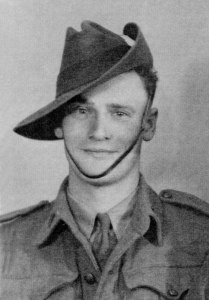

Above: Eric Fraser, Trevor James and Dick Ridgwell
WX8964 ZAPPA, Ernest Patrick (Ern) Zappa trained with 2/4th however did not proceed overseas due to his health. Ern became an active member of the 2/4th Committee. Ern’s brother Lou Zapper also worked at Gwalia Mines. In fact Dick Ridgwell and Lou saw more of each other, often getting in mischief and joining a few fights!
 .
.
Below: Left Zappa with Jim Elliott
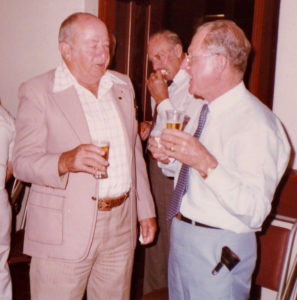
Not included on the above Honour Board:

WX7240 DAY, Donald Alexander (Don or Doodah) was working in Gwalia when he travelled to Claremont to enlist AIF 1 Aug 1940 and later joined 2/4th MGB’s ‘B’ Company 8 Platoon.
Day also died during the short week of fighting to save Singapore. Initially wounded whilst withdrawing No. 3 gun 100 yards to a new position on Mandai Road, Day died soon after.

Don Day was one of four men from 8 Platoon to tragically die on 11 February 1942 aged 28 years. The others were second-in-charge Sgt Richard Sandilands, Raymond Carruthers and Robert Smith.
Born in Jarrahdale Don Day attended school at Jarrahdale Primary and later Rockingham. He also attended Mundijong Sunday School.
His nephew WX17391 Martin William Day enlisted AIF 27 Oct 1941, soon after joining 2/4th MGB as a reinforcement to ‘E’ Coy No. 2 Platoon. Martin Day was KIA at South West Bikit Timah in the same Japanese ambush Harry Mazza lost his life, on 11 Feb 1942. Martin was 21 years old and 7 years younger than his uncle Don.
Their deaths would have been tragic beyond belief for the Day family.
Don Day’s name is inscribed on the Byford War Memorial.
WX14172 EVANS, Francis Clyde ‘Frank or Blue’ b. 25 June 1922 Leonora to parents Cliff and Ivy Lillian Evans.
He worked in the mines at Leonora as a supervisor and enlisted from there.
Frank enlisted 11 June 1941 and joined 2/4th MGB’s Reinforcements ‘E’ Company, Special Forces Battalion which was formed at Singapore. He was promoted to Corporal on 7 Feb 1942 and wounded in action at Bukit Timah 13 Feb during a Japanese ambush when the Company suffered very high losses. Evans suffered a GSW to his left leg and was discharged to unit on 22 Feb 1942.

As a POW in Singapore Evans left by train to work on Burma-Thai Railway with ‘D’ Force Thailand V Battalion. You can read about this Battalion which endured much illness and death.
WX7213 HADDEN, Gilbert Valentine (known as Gil, Bert or Boong) born Kalgoorlie 1908 to parents Gilbert (Snr) and Florence Hadden. Bert enlisted same day at Hadfield 1 Aug 1940 and joined ‘D’ Company 14 Platoon under C.O. Lt Tompkins.

Hadden had acquired a very dark complexion from his years prospecting and was given the nickname ‘Boong’ (which today we may find offensive, but at the time it was not). We discovered in the last few years Bert Hadden’s name has been incorrectly included in the list of indigenous soldiers of WA – ‘Once Warriors’ a book by Janice James of Northam. Ms James was informed, however did not have plans to reprint.
As a POW in Singapore Hadden left by train for Thailand with ‘D’ Force S Battalion as did Hadfield below. When the rail was completed Hadden was evacuated to Chungkai hospital and missed the selection for Japan. He was later sent to Ubon Camp in Thailand from where he was recovered.
Gilbert Hadden’s cousin Lloyd Hadden also joined 2/4th. Their fathers were brothers.

WX7246 HADFIELD, Ralph William Corporal born Leonora 1917 to parents Herbert Thomas & Nancy Teresa Hadfield. Ralph enlisted Leonora 1 Aug 1940 and later joined ‘C’ Company 10 Platoon under C.O. Lt Wilson as a rangetaker.

Hadfield left Singapore with ‘D’ Force Thailand, S Battalion to work on the Hellfire Pass cutting.
He worked at Tarsau, Kanu II, Hintok River Camp then back to Tarsau before being sent to Tamuang Camp where he was selected by Japanese as being fit to work in Japan with what became known as the Rashin Maru party.
Please read further about the extraordinary 70 day journey to Japan on Rashin Maru.
At the end of war Hadfield was recovered from Niihama Mine, Japan on 13 Sept 1945.
He sailed on HMAS Speaker from Manila to Sydney. Read about the plight of Speaker having to wait outside Sydney Heads several days because the Wharfies were on strike.
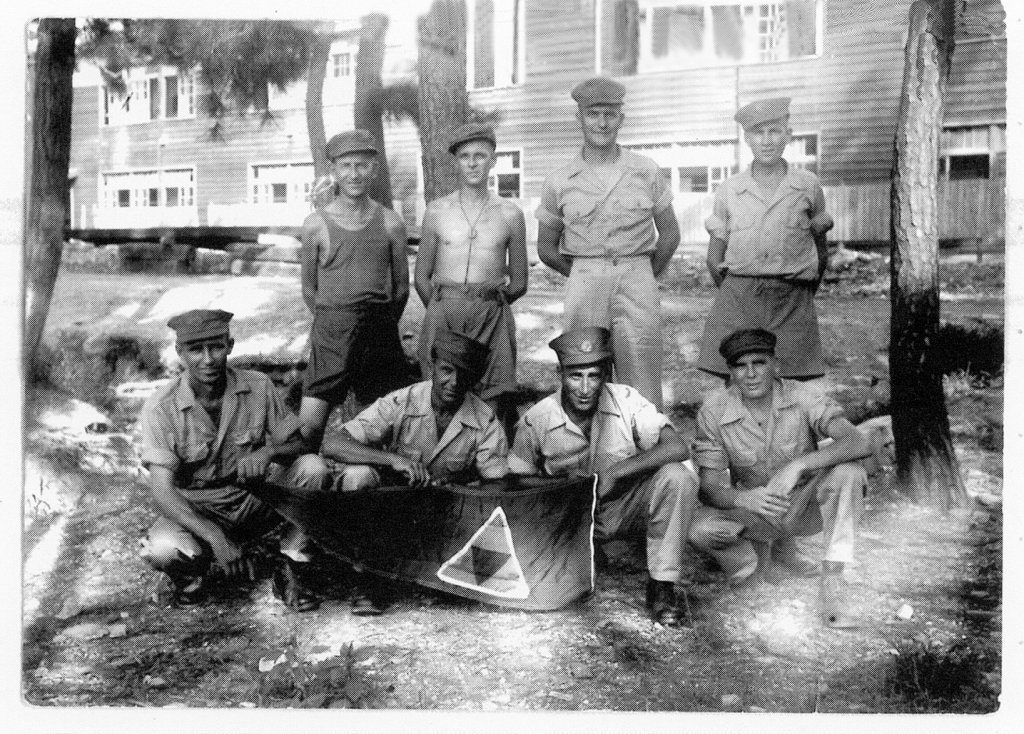
L-R Back Row: Thomas Gibson, Albert Norton, “Cowboy” Matthews, Ralph Hadfield
Front Row: George Chatfield, Norm Thompson, Claude Dow, Andrew “Mick” Lambie.
WX7216 MAZZA, Angelo Enrico (Harry) Lieutenant was born Gwalia 1919 and was living and working Gwalia when he enlisted 1 Aug 1940 same date at Don Day. Perhaps they travelled together to Claremont to enlist. We will never know.
We also do not know which Platoon Mazza was in before being sent to Officer’s school with several other young men. On return he was seconded to the newly formed ‘E’ Company, becoming Commanding Officer to No. 3 Platoon.
He was KIA south west Bukit Timah 12 Feb 1942 aged 22 years in a Japanese ambush with a large number of 2/4th from ‘E’ Company SRB Please read about ‘E’ Company
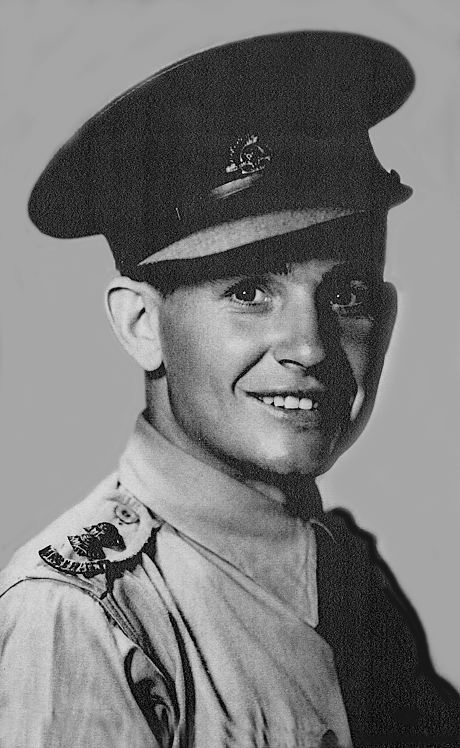
The Mazza family included 4 or 5 sons and one daughter.
When Harry’s father died in 1930, his mother was left alone to raise her children all under the age of 16 years.
Below: Mazza family store. Abandoned in 1963.

Below: Interior of miner’s cottage. Note pressed iron used for walls.

Below: Townsite

Below: famous portrait of Herbert Hoover – who later in life became a well-known American as Head of FBI.

Below: Managers House (Today is a B & B). This is where Hoover resided.



Below: Did you know the Gwalia State Hotel established by the WA Government was the first State Owned Hotel built?
It was opened in 1903. It was built to provide Gwalia with a licensed premise and to combat the sly grog trade.
‘The Sons of Gwalia, at the time one of Australia’s major underground gold mines, provided work for hundreds of people including a large number of Italian and Yugoslav immigrants. The miners erected dwellings in Gwalia from 1898 to be within walking distance of their work.’
Gwalia was home to the first state built public swimming pool.


Above and Below: Interior of Gwalia Hotel in later years.





WX17737 MOHER, Ken born in Gwalia enlisted 21 Nov 1940 from Wiluna where he worked with his brother as a baker. He joined ‘E’ Coy, survived the Japanese ambush at SW Bukit Timah. He was sent with ‘A’ Force Burma to work on Burma-Thai Railway. He was evacuated sick to Konkhan 55 Hospital where he died in 1943.
Ken’s father William Moher had been a foreman at Gwalia Mines.
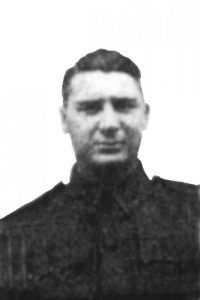
WX7181 MUTTON, Charles enlisted Leonora 1 Aug 1940 and later joined 2/4th’s ‘B’ Company 8 Platoon under Commanding Officer Lt MacKinnon.
He was sent to Burma end of Burma-Thai Railway from Singapore and selected ‘fit’ by the Japanese to work in Japan with ‘Rakuyo’ Maru Party. He lost his life when his POW transport ship ‘Rakuyo’ Maru was attacked by American submarines and sunk in the South China Sea. He died 12 Sep 1944 aged 31 years.
His father had died in 1937 and 5 year old sister died earlier in an accident. The death of son Charles left just two members of the Mutton family – Mrs Bridget Mutton and son Arthur.
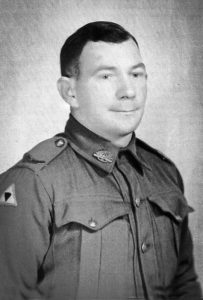
Mutton had been working at the Agnew Goldfields.
He was son to Arthur Stephen and Bridget Agnes Mutton born Perth 1913.


WX86321 BLEWETT, Samuel James was born Gwalia Jan 1914 to parents Samuel James Blewett (Snr) and Mary Reid. He was the third of four children and aged three years when in 1917 his father aged 37 years was killed in a mining accident at Sons of Gwalia. The miner’s death was due to negligence on the part of another employee.
Samuel (Snr) had played and captained the local the local football teams. We have found records confirming his football playing days at Leonora lasted from 1902 until 1917.
Samuel Blewett (Snr) was buried at Leonora Cemetery.
Blewett (Jnr) enlisted Oct 1940, trained as a Rangetaker and served with ‘A’ Coy 5 Platoon under CO Lt’s Walton & Learmonth. Blewett suffered asthma and was not sent out of Singapore on work parties. He spent some time at Kranji Hospital Camp, Singapore.
Blewett (Jnr) died 1959 aged 45 years.
